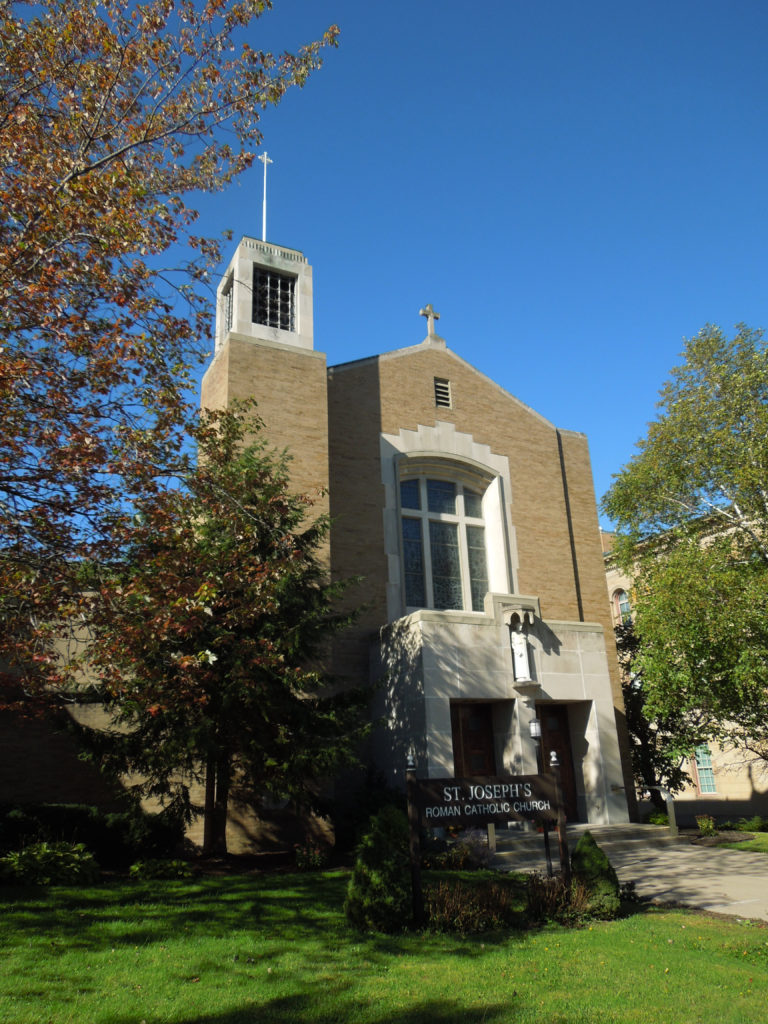St. Mary of the Assumption, St. Stephen the King, St. Joseph, and St. John the Evangelist, City of Oswego – Reflecting Regional Threat to Urban Neighborhood Churches
Update, Fall 2020
Following seven months of study and consultation, in May 2020, Bishop Douglas J. Lucia announced a plan for the Roman Catholic parishes in the City of Oswego. As previously planned, all will be consolidated into a new parish at the former St. Paul’s on Mohawk Street, a 1960s-era building. In a win for St. Mary of the Assumption Preservation Group, the diocese announced that the prominent church building will remain in use as an oratory and a site dedicated to offering the Latin Mass.
According to the Bishop’s letter, St. Joseph and St. Stephen will remain ‘subsidiary or secondary’ churches that should be open for prayer and for celebrating weddings, funerals, and special Masses unless or until a separate canonical process changes the buildings’ designated uses (Catholic Sun, May 21, 2020).
The St. John the Evangelist complex, which was vacated years prior to the other churches and is the oldest of the Oswego churches, remains vacant. Its fate is unknown.
Challenges: Vacancy, Lack of Protections, Lack of Viable Adaptive Reuse Plans
As churches across Central New York experience declining membership and financial resources, communities face the threat of losing some of their most historic and architecturally distinctive landmarks. This is especially true in cities where multiple churches, sometimes geographically close to each other, serve single denominations. Over the past three decades, mainline Protestant denominations have experienced substantial contraction, as reflected by the listing of churches in Syracuse, Cortland, and Auburn in PACNY’s 2018 threatened properties list. Roman Catholic parishes have come under similar pressures, with dozens of parishes merging or closing since the early 2000s in the seven-county Syracuse Diocese.

Roman Catholic church buildings in the City of Oswego are the most recent example of this trend, with four churches consolidated into one parish, Christ the Good Shepherd, in the summer of 2019. The diocese announced that St. Paul’s, the newest of the four church buildings (completed in 1969) would be the site for the new consolidated parish, and the other three churches were closed. Two other historic Catholic churches in the city were previously closed: St. Louis, which was demolished following a roof collapse in 2010, and St. John the Evangelist, which closed in 2001. It was sold by the diocese and remains vacant.
On October 7, Bishop Douglas Lucia, Syracuse’s new bishop, announced that all four parishes would remain open during a 90-day review of the consolidation process. The St. Mary of the Assumption Preservation Group and others had appealed to the diocese, hoping for a Vatican review. Before the review was announced, diocesan officials had not determined future plans for three closed churches. For the time being, they were to be maintained as arms of the new parish, available for funerals, weddings, and special events, or for parish meetings and administrative purposes (Oswego News Now, June 19, 2019).
While none of these Oswego church buildings are under immediate threat and appear to be in excellent condition, with the exception of St. John’s, their long-term use and preservation is in question. Churches are difficult to adaptively reuse; none are listed in the State or National Registers of Historic Places, and the City of Oswego does not have a landmark preservation ordinance. PACNY is listing these churches on the Eight That Can’t Wait to help raise public awareness and support community groups that are working toward long-term positive outcomes.
St. Mary of the Assumption, 103 West Seventh Street
This Gothic Revival-style church, often described as one of the most beautiful in the diocese, is the largest and most prominent church building in Oswego. It is in a residential neighborhood on Oswego’s west side adjacent to the National Register-listed Franklin Square Historic District. St. Mary’s parish was founded in 1848 and the present building was completed in 1925 after nine years of construction and at a cost of $350,000. John T. Comes of Pittsburg was the architect. The 1852 Menelly (Troy) bell from the old church was reinstalled in the new tower. The diocese designated St. Mary’s as one of its alternative basilicas.

In 1997, the tile and copper roof was restored using $470,000 in pledges from the parish, along with assistance from the Oswego Heritage Foundation and the New York Landmarks Conservancy’s Sacred Sites program. In its study of the parish consolidation in 2018-2019, the diocese concluded 20 years’ maintenance of the St. Mary’s exterior could cost an average of $100,000 a year (Oswego News Now, June 19, 2019). Parishioners began an ad hoc “St. Mary’s of the Assumption Preservation Group” to urge the diocese not to close the church. Former parishioners hope St. Mary’s may be maintained as an oratory chapel or shrine.
St. Stephen the King, 140 Niagara Street
This modest Gothic Revival-style church, named after St. Stephen, King of Hungary, is in a quiet neighborhood on Oswego’s west side, about a mile south of St. Mary’s. The parish was founded in 1908 by residents of Polish descent who had come to work in Oswego’s factories. In 1910, the present brick building, with its arched windows, stone foundation, and stout tower, was dedicated. In 2010, the centennial of the present church’s completion, the sanctuary was repainted in new and vibrant colors. According to the church’s website, the renovation was “a sign that St Stephen the King was rejuvenated to face a new future as a living Christian community filled with optimism and trust in God.”

If St. Stephen’s is not kept open, the best use for the building would be another congregation or as a community meeting place that could make use of the large sanctuary. Housing could be a use in this neighborhood, but would most likely lead to loss of the sanctuary.
St. Joseph, 240 West First Street
This Mid-Century Modern-style church is at the south end of Oswego’s downtown. St. Joseph’s parish was founded in 1915 by Oswego’s Italian community. The parish’s first home was in a former Unitarian Church on Second Street and the first services were held there in 1916. The parish grew and in 1956, it began construction on the existing building on the same site. The new church, with its traditional center-aisle nave form, modernist tower, and buff brick walls, was dedicated in 1958. In 1993, a large new parish hall was built on the south side of the property.

If the parish is not kept open, St. Peter’s location on a main commercial road could help make it attractive for use by another denomination, or for adaptive reuse as commercial space.
St. John the Evangelist Complex, 31 Erie Street – National Register eligible
St. John the Evangelist parish was founded in 1869 to serve the growing neighborhood on Oswego’s west side, south of downtown. The present brick Romanesque Revival-style church, described as a “magnificent house of worship,” was built in 1870. A rectory and school were added in the early 20th century.

The Diocese of Syracuse closed the church in 2001 (the school was closed earlier), and the buildings – a total of 31,000 square feet – were acquired between 2006 and 2009 by Priority Rentals, Inc., owned by Oswego resident John Constanza, who rented out the church as event space and later marketed the complex for sale with the assistance of the county economic development corporation, Operation Oswego County. The property, still owned by Priority Rentals, Inc., stands vacant. The church and rectory appear stable, but the windows on the school building are open to the elements. The New York State Historic Preservation Office has determined that the St. John’s complex is eligible for listing in the National Register of Historic Places, which makes the property eligible for state and federal historic tax credits.
The large amount of space in the St. John’s complex reflects the great challenges in adaptive reuse of church buildings. It stands as a testament to what could happen to the other recently closed Roman Catholic churches. PACNY supports efforts by the current owner, city, county development agency, and neighbors to find a sympathetic buyer, and to take measures to ensure that the buildings are properly mothballed.

Sources: Christ the Good Shepherd website, “Heritage Churches,” https://www.christthegoodshepherd.org/heritage-churches/ ; “Churches and Brief Histories in the City of Oswego, NY, 1906;” News reports; Oswego County GIS tax parcel data.



